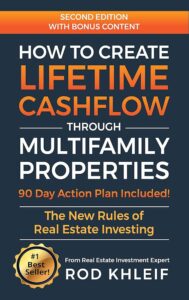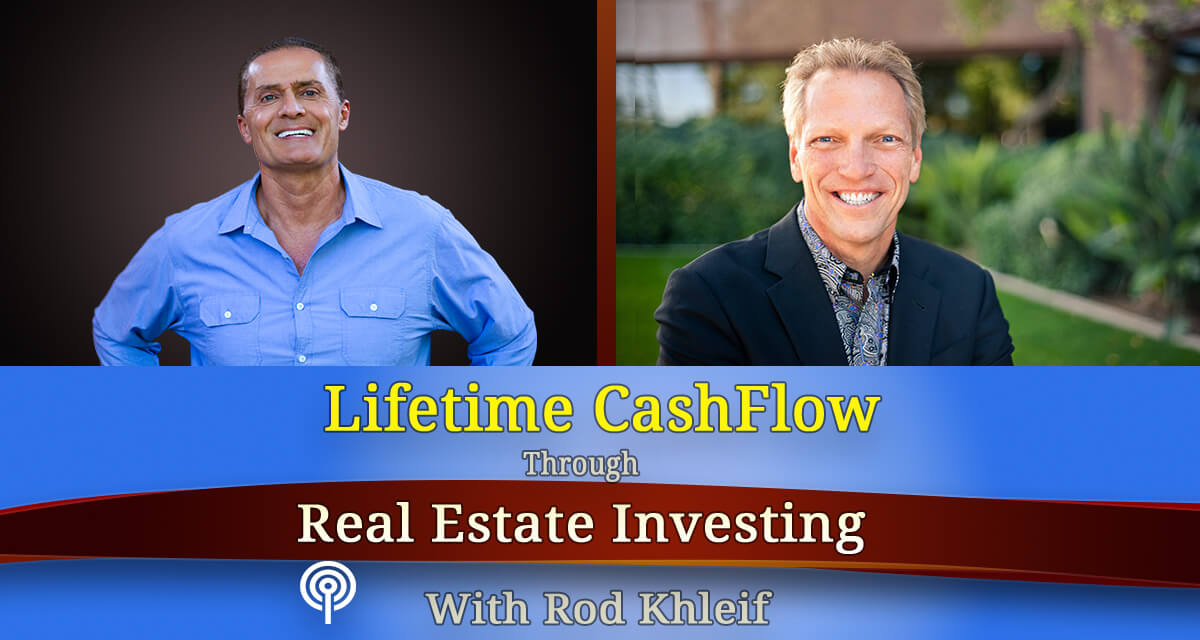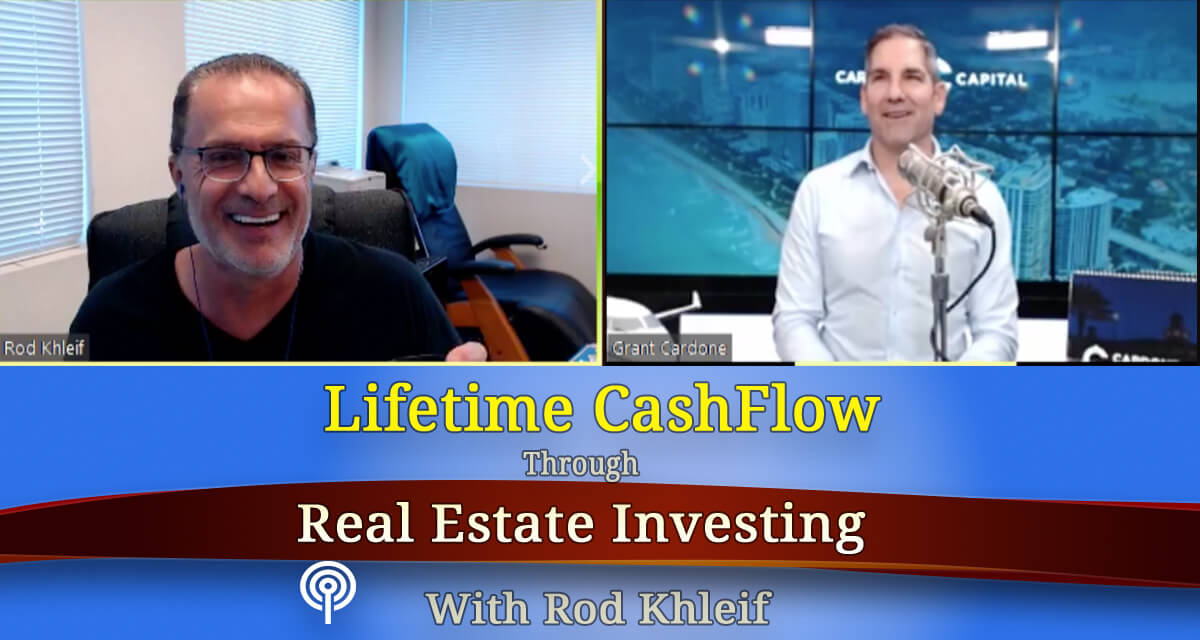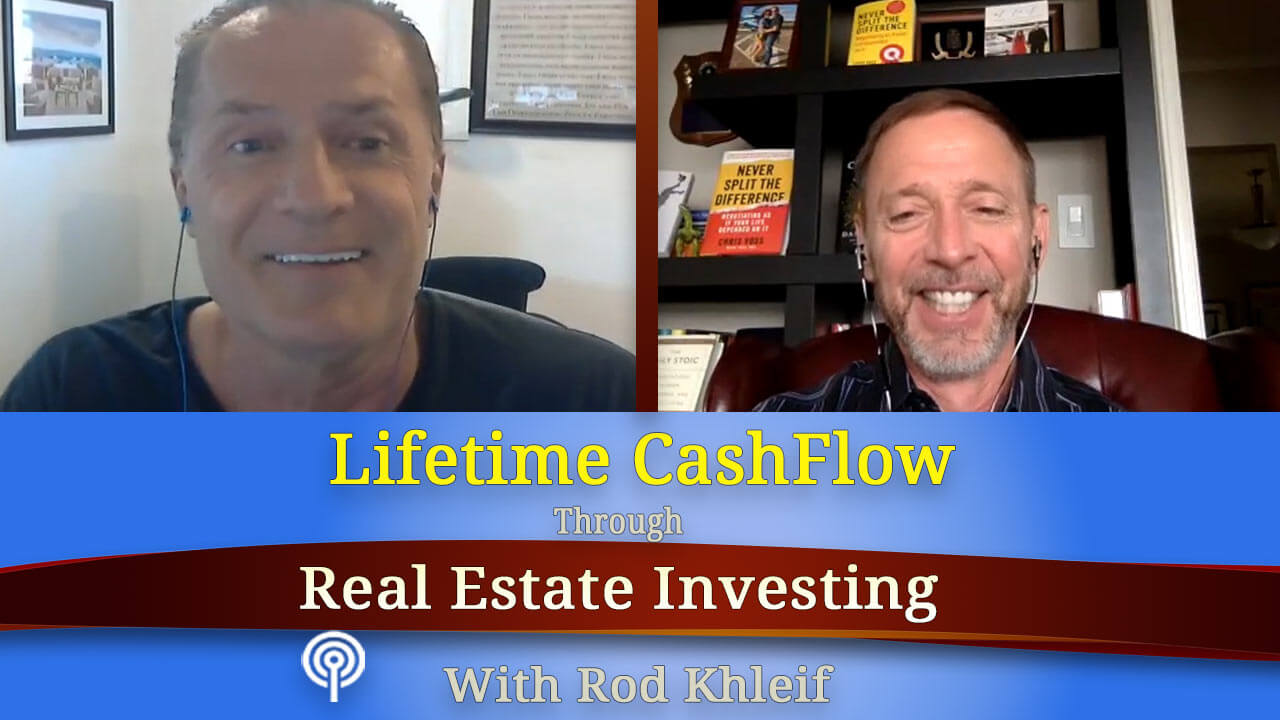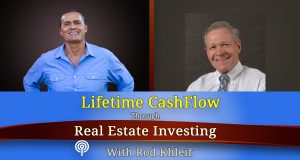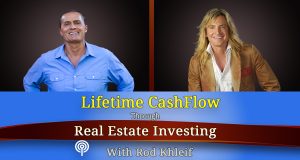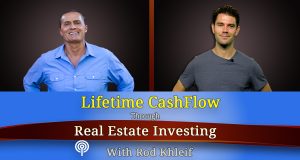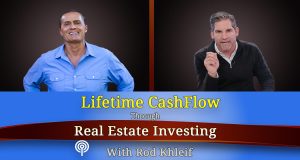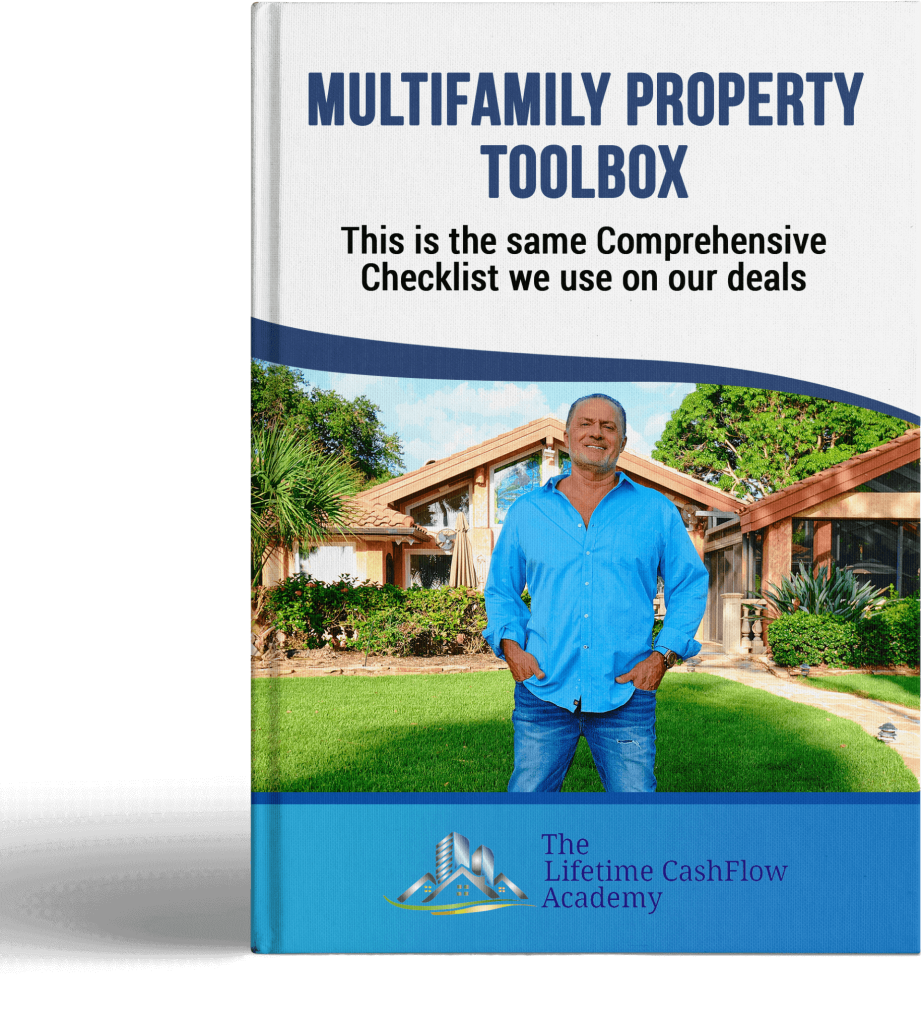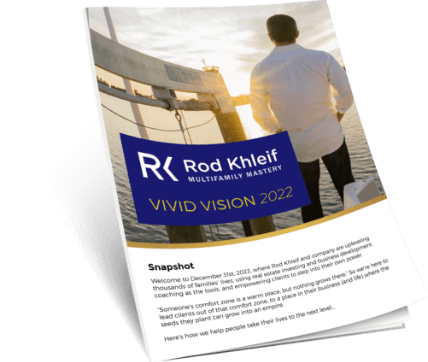Adam Wolfson is the founder, CEO, and CIO of Wolfson BTR, a leading Build-To-Rent (BTR) company recognized for pioneering BTR investment and development. Under his leadership, the firm has built a pipeline of nearly 2,000 units, with an estimated exit valuation of $1 billion, ranking it among the top 10 BTR developers in the U.S. With over 20 years of real estate experience, including leadership roles in Single-Family Rentals (SFR), Wolfson is a prominent figure in the industry. He holds an MBA from George Washington University and a BA from the University of Michigan, and he resides in Miami with his two sons.
Here’s some of the topics we covered:
- From Commercial Real Estate To Build To Rent (BTR) 00:00
- Breaking Ground On BTR Deals 6:19
- Navigating Local Government 12:14
- Mastering Different BTR Strategies 17:06
- America’s Housing Crisis 24:21
- Red-Hot BTR Markets You Can’t Ignore 29:44
- What It Really Takes to Succeed in BTR 32:19
- Just How Massive is the BTR Market? 39:08
To find out more about partnering or investing in a multifamily deal: Text Partner to 72345 or email Partner@RodKhleif.com
Full Transcript Below:
00:00:41:03 – 00:00:59:27
Rod
Welcome back to lifetime cash Flow through real estate investing. I’m Rod Cleef, and I’m thrilled that you’re here. we have an interesting topic to discuss today. It’s BTR or Build to Rent, which is something I’m actually very interested in. Personally. I think it’s a fantastic business model because it kind of ties into what I did in the past, although much smarter than how I did it.
00:01:00:00 – 00:01:16:21
Rod
but I’ve got Adam Wolfson in here today, and, Adam is the CEO of Wolfson BTR, and, they’ve got 2000, homes in a pipeline in this built to rent model. So we’re going to we’re going to dig into this because I am actually very excited about it personally. Welcome to the show, brother.
00:01:16:24 – 00:01:17:10
Adam
Thanks for having.
00:01:17:10 – 00:01:33:03
Rod
Me. Absolutely. So, you know, why don’t you give us a little background on, you know, maybe where you came from, how you ended up in, in this, I read your bio, but I won’t do it any justice. Very, very interesting and very impressive, actually. So why don’t you tell us who you are?
00:01:33:05 – 00:01:57:11
Adam
Sure. So, I grew up in the Midwest. I grew up in the suburbs of Metro Detroit, a place called Bloomfield Hills. spent most of my time there, went to the University of Michigan, and then wound up, moving to Miami about 16 years ago in the Great Recession. Right. And, well, the bio is certainly written in a way to suggest it was all sort of, trending upward.
00:01:57:18 – 00:02:25:04
Adam
You know, I probably had seven different jobs since I moved to Miami, and just sort of worked my way up through different commercial real estate groups, learning as I went and, you know, consistently trying to just understand more about the business, taking a bigger title as I went. And then at some point, I wound up coming across this piece of land in Bradenton, Florida, and this is before the term BTR existed.
00:02:25:04 – 00:02:38:29
Adam
There was no build to rent. a family partner of mine own this piece of land, and it was underwater trying to sell it to D.R. Horton and D.R. Horton was, you know, giving them the runaround there. And it turns out that, he was kind of stuck. And so he said, can you take a look at this?
00:02:39:01 – 00:03:02:22
Adam
And I was finally at a point in my career where I could underwrite. I knew how to use Excel. Well, I knew how to pitch institutional investors. And, you know, I sort of took a step back and I said, well, this is supposed to be a townhome community for sale. Couldn’t get a deal done for the life of me at that time because cap rates were going to crazy places, and you didn’t want to really chase that down.
00:03:02:24 – 00:03:28:19
Adam
But I had the idea to throw this into my multifamily development model, and it shot back a seven and a half untended yield on cost. And to put that in perspective, we were doing deals at sixes and which were really five, nine, five eights when you dug into the underwriting. And that’s sort of what the spread was. When I dug in further and realized I was using vertical construction numbers for this thing, and I dialed in the right numbers.
00:03:28:19 – 00:03:32:18
Adam
It was an eight and a half on trend. It and I said, this is interesting. Yeah, this is what I need to do.
00:03:32:22 – 00:03:50:08
Rod
By the way, guys, just to backtrack for a half a second. So he was trying to sell or Horton there a builder okay. So he’s trying to sell that to to basically a builder. Yeah. He couldn’t sell it. you ran the models on this. and you’re saying you were doing vertical meaning multiple story. Is that what you’re saying in the multifamily space?
00:03:50:08 – 00:04:00:04
Rod
Right. And then you realized, you know, you’re building single family. It’s it’s a totally different model, and you can price it a hell of a lot more reasonably correct. That’s that’s to summarize what you just said.
00:04:00:04 – 00:04:19:07
Adam
Yeah. I mean, I think we were running costs at about $240 a foot on net foot, and it was about 100 bucks a foot less to build the single family homes. I think the cost that the public builder eventually had to their direct cost to build these units was about 64, $65 a square foot.
00:04:19:07 – 00:04:25:00
Rod
Wow. That’s a hell of a price, right? Man, I’d love to build for that. Right? We can build everything I can get my hands on.
00:04:25:00 – 00:04:32:17
Adam
Can’t do that anymore. Now, now, I think your your your net foot these days is probably give or take 100. Yeah. Not 90 to 100.
00:04:32:17 – 00:04:47:18
Rod
Yeah, I would do that all day. And I was telling you before we started recording, I want my son to get his general contractors license so we can build some stuff down here to rent. I mean, I love the model. And so you, you went to school in, Ann Arbor. Is that where it was go blue?
00:04:47:19 – 00:04:55:24
Rod
You know who might. You know who my first interview was? Albert Barris. You know that name he owned? McKinley Corporation owns it. Sure, a huge company.
00:04:55:25 – 00:04:57:01
Adam
He was an ambassador, right? Yeah.
00:04:57:01 – 00:05:15:13
Rod
Yeah, he’s. Yeah, he’s he’s huge up there. And he’s a billionaire is really funny. Funny story. I just as an aside, he he came and spoke. I spoke at my mastermind. I have a host, a mastermind of multifamily operators, and, and, my assistant called his assistant, said, yeah, we’re going to fly Albert down. We’re going to first class.
00:05:15:13 – 00:05:32:17
Rod
We’re going to put him up at the Ritz Carlton and his assistants, like, now he’ll take his own jet down. It’s fine. Like, yeah, maybe. Anyway, it’s really funny. He was my first interview. I’m an hour in, I realized I forgot to hit the record button. so we were talking about you starting a podcast. Please remember to hit the frickin recording button.
00:05:32:20 – 00:05:42:26
Rod
Yeah, he was really cool about it. Oh, my God, I was mortified. Anyway, so you bought this. This Bradenton piece of property. You developed it. let’s continue with that story. So. Sure.
00:05:43:02 – 00:05:47:26
Adam
So. So I wound up, partnering with a large SFR operator at that time.
00:05:47:26 – 00:05:48:24
Rod
Single family rental.
00:05:48:24 – 00:06:17:25
Adam
Single family homes for rent operator. wound up actually working for them as their chief investment officer, managing a portfolio of about 4000 homes while standing up this build to rent business. Nice. And, so we we partnered with with with one of the big publicly traded builders. They financed it. They built it for us. They got to count it as sales, on their end and then right as we’re about to break ground on this thing, you know, we need to show essentially what our take out financing is going to look like.
00:06:18:01 – 00:06:27:20
Adam
And so we go to the debt markets. The debt markets have no idea what to do with this thing, because you’re going to be delivering vacant units one at a time, right over the course of a year and a half.
00:06:27:21 – 00:06:31:03
Rod
Right. They’ve unlike a multifamily project that you’re developing.
00:06:31:03 – 00:06:46:05
Adam
Right? Right. Multifamily. The difference is when you deliver a multifamily project, you essentially have your construction loan and you’re going to lease up the property while you have your construction loan. And then once you’re 94, 90, right, and like 90% occupied for more than 90 days.
00:06:46:07 – 00:06:47:16
Rod
Conforming debt or Freddie.
00:06:47:16 – 00:07:04:15
Adam
You refinance into a more permanent solution. This needed something in between, which is one of the nuances of these BTR deals. You’re not dealing with the typical construction lender, right. And so you have to find somebody who’s willing to step in in the middle. They’re going to take risk. That’s a little bit less than construction risk because they don’t have to build.
00:07:04:15 – 00:07:12:02
Adam
The units are complete, but they’re not going to have a stabilized unit. So they have to step in essentially as a bridge. And that’s what it’s become.
00:07:12:05 – 00:07:13:04
Rod
so it’s the bridge debt you had.
00:07:13:04 – 00:07:31:25
Adam
It’s bridge debt. Right. And so we had to convince essentially an SFR lender, a single family homes for rent lender, because a lot of those guys were giving the larger companies these lines that they could use to go buy from, you know, three homes here from Dr., two homes there from Lennar, five from pool. And so they had these lines and we said, guys, it’s the it’s the same thing.
00:07:31:25 – 00:07:38:21
Adam
Right. And they they finally, you know, scratch their heads as big institutions do. And they came back and said, okay, we can do this. And so as we’re listening.
00:07:38:28 – 00:07:52:20
Rod
Let me just give you kudos, okay? Because you could have just said, oh, this isn’t going to work. And you just went out there and, and you had to sell them on this and, and convince, you know, people that have done things the same way forever, that there’s a different way to, you know, to skin a cat here.
00:07:52:27 – 00:08:11:06
Adam
I appreciate that, but we can go backwards in a minute because the story I was telling you where we started underwriting this, it became so clear that this was going to happen. Right? Right. That there’s no there’s no way they should say no. This is the same as what they’re doing. It wasn’t like, let me try to get them to say yes, it’s guys, this is the same, right?
00:08:11:09 – 00:08:14:07
Adam
There’s no reason you would say no. You couldn’t you couldn’t justify it.
00:08:14:12 – 00:08:18:12
Rod
When you approach it with that certainty, then it’s done. You know that’s that’s good. Awesome.
00:08:18:12 – 00:08:41:06
Adam
And so, we wound up getting a few lenders to, to give us, quotes on this thing to give us term sheets. And one of them was, JP Morgan Asset Management. I can say it now because we wound up selling to them. And as we’re going through the the process of sort of negotiating a term sheet and lending, they came back to us at one point and said, can we just buy this from you?
00:08:41:09 – 00:08:41:29
Rod
No kidding.
00:08:41:29 – 00:08:58:11
Adam
So, well, let me see what that looks like. And so they they gave us an offer for it, and we went back and forth a little bit and I said, you know what? This is the first deal. At the time, I needed the money. Right? I still need the money. Right. But but at the time, like, this was going to give me what I needed to sort of start a company and go.
00:08:58:11 – 00:09:08:29
Adam
And so while I’d like to have kept that unit and in hindsight, their rents ran 35% during Covid, right? You know, they made I think they did a lot better than what they were underwriting. But, you know, well.
00:09:08:29 – 00:09:28:22
Rod
We’ve seen this this this MSA went up 30%. The rents went up 30% in one year, right? Like I was I was 23 or 22. Yeah. So yeah, it was a home run for them. But but it’s exactly what you needed. And you know, the parallel sorry interrupt here. But the parallel is for people starting out in my business and multifamily space.
00:09:28:26 – 00:09:38:23
Rod
You know, if, if you can do a quick sale on something early on that set you up for future success, that’s a no brainer. Even if you have to take it in the shorts a little bit, it’s a no brainer.
00:09:38:29 – 00:09:58:02
Adam
Yeah, and you know, like I said, I would I would love to still have that. Yeah. but in selling that, we wound up raising a fund right after it because our investors knew exactly what what they were going to be getting. Right, right. We, we knew before we put a shovel in the ground what our cost was because we had a GMP out of the public builder, they couldn’t come back to us for more.
00:09:58:04 – 00:10:02:02
Adam
Right. And we knew what we were selling. guaranteed maximum price contract that.
00:10:02:02 – 00:10:03:05
Rod
They.
00:10:03:07 – 00:10:09:26
Adam
They mean nothing anymore because after, you know, after, all the, inflation and cost.
00:10:09:28 – 00:10:11:17
Rod
Building and cost of building.
00:10:11:17 – 00:10:24:23
Adam
Something. Right. And so all the guys that used to give them, they’ll still give them to you, but they’re not going to go out of business and lose their homes too. Right? So at a certain point when costs go up 20, 30%, right, like they did, post Covid, they’re going to come back to you and say, guys, we need to.
00:10:24:23 – 00:10:25:09
Rod
Talk.
00:10:25:09 – 00:10:32:09
Adam
Right? Right. Let’s find a way through this. very different from what was before that they could eat 5% right, you know.
00:10:32:09 – 00:10:49:27
Rod
Right. Right. Right. Right. Yeah. And I remember seeing, a post on social media where, where people were, you know, this is my this is my wealth creation. It’d be a pile of wood. You back then, it was crazy what happened there? So. So you sold it to JP Morgan Chase? Yeah. Had a nice hit. And you’re off and running.
00:10:49:29 – 00:10:50:19
Adam
Off and running.
00:10:50:19 – 00:11:08:14
Rod
Okay. And so talk about some of the other projects that you’ve got going. I want to drill down on this quite a bit more. So just so you guys know. So build a rent is you basically building up a home subdivision and you’re renting it. Okay. And, you know, I mean, it’s it’s just, taking what we’re doing in the multifamily space and spreading it out.
00:11:08:14 – 00:11:24:26
Rod
And, you know, and I was saying this to you before we started, I mean, people would much rather live in a house than a freaking apartment any day of the week. And so, you know, obviously there’s going to be a, I’m sure a, what’s the word I’m looking for? it’s going to cost more to live in a house than it’s going to cost to live in an apartment.
00:11:24:26 – 00:11:28:15
Rod
But, you know, people really like it. And you’re focused here in Florida, correct?
00:11:28:19 – 00:11:36:26
Adam
Southeast US. But I have not been able to get a project on the books. It’s outside of Florida. We’ve chased a lot of them. But, all of our pipeline is here in Florida.
00:11:36:27 – 00:11:39:21
Rod
Okay. So talk talk about the different projects you’ve got going right now.
00:11:39:26 – 00:11:49:07
Adam
All right. So we have a 350 unit deal in, Daytona Beach, Ormond Beach that will break ground on in the next call it 6 to 9 months.
00:11:49:10 – 00:11:51:19
Rod
do you do the entitlement and all that stuff? Correct. Yeah.
00:11:51:20 – 00:12:08:29
Adam
Okay. We are where we’ve really been able to create value. is is in buying the land. Right. And our fund allows us to buy the, to buy the dirt. Most of the, the groups out there that are going to get sort of institutional capital, they can’t deal with the entitlement process. They can’t deal with,
00:12:09:01 – 00:12:10:14
Rod
Because of the time constraints.
00:12:10:17 – 00:12:34:02
Adam
The time constraints and the uncertainty and the sort of pain in the ass of dealing with, you know, local governments. Right? You’ve got you’ve got, stormwater management. So you got your local water management district. You got to dig enough lakes to deal with the runoff that you’re going to create. You’ve got wetlands. So, in the wetland process, it used to be the Army Corps of Engineers that you deal with, right.
00:12:34:05 – 00:12:55:23
Adam
which was a treat. And then, you know, they, off, sort of outsource that over to the Florida Department of Environmental Protection, FDP. Oh, lovely. They then got hit recently with a lawsuit, by some groups in DC saying, hey, you’re doing it wrong. You’re not protecting the protecting the species down there, the endangered. And so they halted everything.
00:12:55:23 – 00:13:13:23
Adam
And now you have to run everything back through the Army Corps of Engineers. those kinds of things come up all the time. You get bald eagles nest that can appear. You’ve got gopher tortoises. There’s any number of things. And that’s, you know, assuming that your project is entitled and zoned for what you want locally, you may have to go through some of that.
00:13:13:25 – 00:13:30:20
Adam
And our fund is really allowed us to sort of get in early and create value and spend the two years that it takes to go through those processes. And so, you know, it looks like all these things come up overnight and everybody has a groundbreaking ceremony. But in reality, our projects are two years, two years in the making.
00:13:30:20 – 00:13:37:14
Rod
Yeah, yeah. So when you say you create value right out of the gate, could you elaborate on what you mean by that? Yeah. When you buy by buying it. Right.
00:13:37:16 – 00:13:55:18
Adam
You by buying it. Right. But you so if you go in and buy an entitled piece of dirt from someone, like if I were to go out and sell the land that I bought and spent two years and half $1 million, getting entitled. Right. These are sites that are 50 acres, 30 acres, 200 acres in some cases.
00:13:55:24 – 00:13:59:09
Adam
And so you’re going through and spending money on,
00:13:59:12 – 00:14:03:18
Rod
Roads and sewer lines and before that.
00:14:03:20 – 00:14:11:20
Adam
land use attorneys, engineers, architects to put things together, lobbyists to help you when you need it with.
00:14:11:22 – 00:14:11:26
Rod
Yeah.
00:14:11:27 – 00:14:34:20
Adam
Yeah. I mean, you’ve got to go through these processes and, you know, you’re you’re putting a site plan together. You’re literally taking a piece of dirt that is essentially raw and saying, okay, here’s what we’re going to do. And then you’ve got to get that approved at every different level that the local level, like I was saying. So they prove your roads and sewers and where you’re going to be putting the houses in the densities and the heights and the colors and the trees and the landscaping.
00:14:34:21 – 00:14:35:09
Adam
Wow. All right.
00:14:35:09 – 00:14:49:12
Rod
So that’s how you create the valley, correct? Okay. It’s you haven’t even picked up a shovel yet. You’ve just basically got it in. That’s what it means. Okay. Well, this is this is news for me too. So this is very interesting. So you’ve got that one. Where else have you. You mentioned some other stuff. Yeah.
00:14:49:12 – 00:15:10:06
Adam
So we sold the 184 units just down the street in Bradenton, Florida. We’ve got another 274, 274 units that will break ground in the next 2 to 3 months. just north of Bradenton and Palmetto. Oh, yeah. we have another project. about 80 acres in Bradenton as well. Bradenton has been very good to us.
00:15:10:12 – 00:15:31:04
Adam
it’s great market here. we have another, just under 70 acres that we bought in Fort Myers, where we’ll be breaking ground in about 304 townhomes. in the coming 2 to 3 months there. Wow. It’s got a second piece there that will either do as a multifamily of 300 units or a cottage style BTR, which is a little bit different.
00:15:31:07 – 00:15:31:27
Rod
So what does that mean?
00:15:32:03 – 00:15:42:09
Adam
So most of what we’ve been doing BTR and may we take a step back. Build to rent generally refers to entire communities of homes for.
00:15:42:09 – 00:15:44:12
Rod
Rent, right. Like a subdivision for homes basically.
00:15:44:12 – 00:16:06:11
Adam
Right. It’s it’s essentially the cousin of multifamily because those are usually studios, ones and twos right there for rent. But they’re centrally managed, right. And single family homes which are scattered all over the place, SFR for rent. And so those things are sort of put together now within build to rent BTR, there’s really sort of two camps. One is the individually platted.
00:16:06:13 – 00:16:10:15
Adam
Right. So each house has a tax folio, which is what we’re doing. Oh okay.
00:16:10:15 – 00:16:12:25
Rod
So we oh no kidding. So each house has separate taxes.
00:16:12:25 – 00:16:14:04
Adam
That’s how we’ve done it. Interesting.
00:16:14:04 – 00:16:20:16
Rod
So if you ever want to sell you can sell individually. Right. That’s smart. That’s great. So ultimate alternate exit plan.
00:16:20:17 – 00:16:22:04
Adam
Correct. And so the investment.
00:16:22:05 – 00:16:28:17
Rod
And are you going to pay more in taxes that way? Likely. Yeah. But but but it’s a it’s great to have that second exit plan. Yeah.
00:16:28:17 – 00:16:34:17
Adam
And so a lot of the institutions, they’ll check that box at an investment committee knowing that they’ll probably never use it. But investment is.
00:16:34:18 – 00:16:35:04
Rod
What I’m sorry.
00:16:35:04 – 00:16:36:02
Adam
The exit as.
00:16:36:05 – 00:16:37:23
Rod
Well as that alternate. Yeah.
00:16:37:23 – 00:16:57:02
Adam
Because they look at is NOI divided by cap rate, which is how they’re going to sell this thing in the end. But if they ever had to and now it’s honestly right now is the only time it’s ever really gotten close where the value for the retail home might exceed the value of the cap rates. Right. Because cap rates blew out when debt got more expensive.
00:16:57:02 – 00:17:17:07
Adam
Right. And so it it finally got a little close. I think that’s turning the other way. But anyway, Build to rent has really two different types of of execution. One is that individually platted where you’re essentially building three, 4 or 5 bedroom homes or townhomes. And these are generally starter homes. They’re smaller homes in 1500 feet for three, 2000 for a four at max.
00:17:17:07 – 00:17:17:28
Adam
Oh no kidding. Yeah.
00:17:17:28 – 00:17:20:00
Rod
They’re not they’re not smaller. They’ve garages.
00:17:20:02 – 00:17:34:17
Adam
They have garages. Not everybody has it. But we do when you’re doing an attached or. Sorry an individually platted home, you’re doing that. There’s another camp within BTR, which is essentially cottage style or horizontal apartments. They’re calling that right.
00:17:34:17 – 00:17:36:07
Rod
And so so they’re attached.
00:17:36:07 – 00:17:43:06
Adam
They’re attached like a townhome. But, they have their own yards, single store. Some are two, but it’s still one.
00:17:43:06 – 00:17:53:23
Rod
Unit, almost like a zero. A lot line. No no no, no, I’m thinking of something else. I think I’ve got some up the road here actually. But, so so they’re attached. But but they’re single story generally.
00:17:53:23 – 00:18:10:00
Adam
Single story. There’s some groups doing to like a living room downstairs and a bedroom upstairs. They have their own backyards and but they’re going to be ones, twos and studios for the most part. Just like multifamily. So this sort of is to me, it’s a little bit in between multifamily and the way we’ve envisioned it, desirable.
00:18:10:00 – 00:18:34:08
Rod
You know, I look at some of these multifamily assets that are these old 60s built with they’ve got pitched roofs in there like four, five, six plexus, eight plexus, but they’re single story. And those are also very desirable. I mean, they don’t look the greatest. A lot of them don’t have central air and whatnot. And, or, and, or you know, they’re very small, small windows, low ceilings, but that’s it’s very similar to what you’re describing here.
00:18:34:08 – 00:18:42:16
Rod
And they’re still very desirable because people that don’t have someone living above or below them, just next to them. So it’s still, like I say, a desirable setup. So you’re doing that?
00:18:42:20 – 00:18:49:29
Adam
No, we haven’t done the cottage style yet. We on that piece of land in Fort Myers where we’ve got this extra call it 25 acres, we’re considering.
00:18:50:03 – 00:18:50:06
Rod
It.
00:18:50:07 – 00:18:58:00
Adam
Multifamily or that, but it will. It will probably wind up being some form of BTR there, cottage style or others. That would be our first call.
00:18:58:00 – 00:19:01:28
Rod
Obviously the density is less if you’re going to do cottage cuz you can’t go horizontal, correct?
00:19:02:00 – 00:19:12:02
Adam
Vertical, correct. So I would go from about 300 units more vertically, right in 3 or 4 story product to give or take 200 units on that piece. But so that that’s our pipeline.
00:19:12:05 – 00:19:34:14
Rod
well, yeah. The reason I’m fascinated, you know, you don’t know a lot about my story, but I had 800 houses along the Gulf Coast of Florida here, but in a two hour direction each, each direction from where I live, two hours north to our south and everywhere in between. And logistically, it was a friggin nightmare. And you’ve managed some SFR single family residence this you understand this dynamic as it relates to maintenance and things like that.
00:19:34:14 – 00:19:49:21
Rod
You know, I tell the story, you know, if I had a maintenance issue at one of my apartment complexes, you can stockpile parts. Everything’s the same. But if these are all differently built houses, which these were, you know, you’ve got to go see what’s wrong. Might be an hour one way for one of my maintenance guys. And then you’ve got to find a Home Depot or a Lowe’s.
00:19:49:22 – 00:20:05:04
Rod
We have an account, and I don’t know about you, but when rod tries to fix something, he ends up going to Home Depot more than once. And, you know, and these were C-Class houses for the most part that I bought. And so lots of maintenance and, you know, so literally it was it that killed the cash flow killed it.
00:20:05:06 – 00:20:18:26
Rod
But but I love the model where they’re all together because and they’ll likely have the same appliances, plumbing fixtures, things of that nature. So from a maintenance standpoint you can have a maintenance room and stockpile parts just like you do in an apartment complex. Yes of course. Yeah, yeah.
00:20:19:02 – 00:20:33:21
Adam
We also do central amenities. So no different. So no different than like a class pool, gym. Nice. you know, bath park. Yeah. nice. children’s parks. Nice. we’re going to be putting in pickleball courts in some of these.
00:20:33:22 – 00:20:42:03
Rod
I’m putting a change in the tennis court to pickleball right now in an asset we just bought in San Antonio. I don’t even know what pickleball is. I guess that’s the big rage, but I’ve never tried it or anything.
00:20:42:03 – 00:20:45:21
Adam
But, yeah, I’ve never played it either. My partner’s big into racket sports. Loves that.
00:20:45:22 – 00:21:05:16
Rod
Yeah. No kidding. Oh. That’s funny. So, So. Yeah. So I mean, we’re talking a little bit before we started recording how, you know, you’ve been. I don’t know how you described it. where you just buying. I’m sorry. You’re you’re building and selling immediately. Almost like flipping. How did you. What? Merchant building. Merchant builder. Right. Okay. Which is very common.
00:21:05:16 – 00:21:18:04
Rod
Even in the multifamily space, somebody will build a big multifamily and they’ll they’ll get it partly leased up or mostly leased up and or maybe not even leased up and sell it immediately. but now you’re leaning more towards buy and hold. Well.
00:21:18:06 – 00:21:19:05
Adam
More build.
00:21:19:05 – 00:21:20:07
Rod
And then I mean build.
00:21:20:13 – 00:21:33:13
Adam
Recap and hold it or, you know, personally buy these units and I can keep holding, you know, the. I think as we talked about a little bit before, we were a nation of renters. That’s not going to change.
00:21:33:13 – 00:21:35:10
Rod
Oh no. We have become a renter nation question.
00:21:35:15 – 00:21:53:25
Adam
And I think that it only continues. We can talk about some of these tailwinds. I think that that are behind the BTR space. And so if I could hold these things forever, right. There’s always sort of a mismatch between capital and sort of the business plan. Right. If you want a merchant build, there’s plenty of opportunistic capital that wants to do that.
00:21:53:25 – 00:22:10:22
Adam
They want their money to come in and out real fast. Right? There’s some groups that want the value add and they can deal with maybe a little bit longer. Right. There are a lot fewer investors that are willing to take that core plus or that core sort of let’s just buy something that has cash flow and hold it, or let’s lease it up and hold it.
00:22:10:28 – 00:22:19:00
Adam
They want their money out faster. And so matching capital to the business plan or your goal is really always the challenge.
00:22:19:00 – 00:22:37:13
Rod
I will tell you, you know, our model is it’s kind of the BR method honestly on a bigger scale, you know, buy, reposition, refinance, get our investors all or most of their money back and they just hold on to the damn thing. And, you know, unless the market shifts or something like that. And, and so I believe you could absolutely do that in your model, no question.
00:22:37:13 – 00:22:56:01
Rod
And, but, you know, we talked about the, the renovation piece. You know, there’s a huge disparity now, but between, what someone can rent a place for and what they can buy it for. It’s it’s becoming very, very difficult for people to buy at this point. And I don’t know if that’s going to shift. but if not, we’re going to continue to move more towards a renter nation.
00:22:56:01 – 00:22:58:19
Rod
So you talk about tailwinds. What are some of the other tailwinds.
00:22:58:21 – 00:23:07:06
Adam
Right. So with with apartments, right. Like you have somebody who is just mainly starting out, right. For the most part at first.
00:23:07:06 – 00:23:08:26
Rod
What do you mean? Oh, you mean like a, like a rent.
00:23:09:00 – 00:23:33:02
Adam
Younger renter, right. They they’ve moved out. They graduated college or they’re in college. They’re working a job. sometimes it winds up as a couple, but generally speaking, and in most of the apartment communities that were built, they built only 5 to 7% three bedroom units. Right. And that was from 1990 until now. And so at a certain point, you’ve got all these people who are sort of funneling through this multifamily system, right?
00:23:33:02 – 00:23:38:02
Adam
They’re funneling through apartments. And at some point they get a dog or a kid.
00:23:38:02 – 00:23:38:13
Rod
Yeah.
00:23:38:13 – 00:23:56:09
Adam
Or they want to work from home now post-Covid. Right. So all these things sort of pushing these people and the people who are in the three bedrooms, where would they go? They would eventually go into the home buying market, right? The home buying market. Now as you to your to your point, it would cost them from the last.
00:23:56:09 – 00:24:17:02
Adam
It is a $4,473 inclusive of their mortgage payment, their taxes and their maintenance to own the same unit, they can rent from me for about $2,500 a month. Right. And so it’s about a 70% delta. And that, by the way, holds nationally, give or take, in terms of what it cost to rent a home versus what it costs.
00:24:17:02 – 00:24:29:28
Adam
Oh, yeah. To, to own it. And so what’s that driven by? Well, before, the recent, uptick in interest rates, we were about 5 million homes short in the country. That’s exactly right.
00:24:30:01 – 00:24:30:21
Rod
That’s the number.
00:24:30:21 – 00:24:53:02
Adam
And from 2012, to call it, I don’t know, 2018, somewhere in there we were forming households, essentially 200,000 more households per year than we were building homes. So the number of starts was already sort of not able to keep pace. And that was when rates were low and times were good. And so what happens when rates go up?
00:24:53:05 – 00:25:11:10
Rod
Okay. Building a it’s almost died at this point. I mean there’s stuff that was already started. But I’ve got I’ve got a partner I shouldn’t say partner. My attorney is 9000 units and he’s struggling to get he’s got some land in Texas. He’s struggling to get it capitalized at this point. so I mean, it’s ground to a halt, right.
00:25:11:10 – 00:25:21:24
Adam
And so and so you’ve got that is the tale when you’ve got all these people, they’re continuing to form their households, and at some point they need to leave multifamily, right? They need to get something bigger.
00:25:21:24 – 00:25:30:14
Rod
And not to get political. But I’m going to get political. What about the 17 million people that have come across the southern border, supposedly in the last year or two as well? I mean, these people need a place to live, right?
00:25:30:14 – 00:25:52:04
Adam
And they’re coming to states like ours, the red states to and, you know, a big proponent of building building in red states. But, you know, look, so you’ve got this huge tailwind of people that need space. The households are continuing from. And so what happened during the past two years, 2 million homes shortage in just the past since 2022.
00:25:52:07 – 00:26:12:10
Adam
Right. So it went from 5 million homes that we were short before to a shortage of now 7 million homes. There is nothing that you can do to fix that over the next 20 years, because even in good times, remember you’re only you’re adding to the deficit by about 200,000 homes a year. You’d have to up your game substantially during good times to just break even.
00:26:12:13 – 00:26:27:18
Adam
Right? So if you have this, you have that many people trying to get into a home, but you’re not able to to provide that for them. And then in times of higher rates, even when they can perhaps find one they can’t afford it because it’s 70% more expensive. Where do you think rents are going to go? They have to go up.
00:26:27:18 – 00:26:46:12
Rod
Oh, they definitely going up, you know, and and you know, I, I, I, I, I got interviewed on a couple of podcasts here in the last few couple of months and, and I found some stats, you know, around inflation. Yeah. I don’t know if you know that 80% of the currency in circulation right now has been printed in the last four years.
00:26:46:12 – 00:26:47:21
Adam
I saw something similar. Didn’t know. Yes.
00:26:47:21 – 00:27:08:16
Rod
80. Yeah 80%. So up till 2020 20% of the currency was was there in the last four years, 80% more has been of course printed out if you’re not even printed, digitized out of thin air. And so we wonder why this inflation and you know, the fed just came out literally yesterday of the day before saying they have to keep an eye on inflation.
00:27:08:16 – 00:27:25:19
Rod
They don’t know when rates are going to come down. Well, I don’t know that they’ll ever come down, you know. And and on that note, I remember you know, I’m a lot older than you. And I remember when I was 18, interest rates were 18%. Yeah. And we were doing backflips when they hit 7%, you know, it was like, Holy crap, it’s 7%.
00:27:25:19 – 00:27:49:06
Rod
Can you believe it? So, you know, just to give some contrast, but so yeah, I again, I love the model. I really love what you’re doing and and frankly, I’m interested in it myself. Like I said, I think it’s a no brainer because people people need a place to live, and they love having their own place like that versus a, you know, I mean, listen, I’m in the apartment business.
00:27:49:06 – 00:27:55:19
Rod
I love the apartment business. But, you know, I’m just from a common sense standpoint, you know, that people would rather have their own place like that.
00:27:55:21 – 00:28:07:23
Adam
There’s a place for both. Obviously, you know, that people are always going to need the apartments at a given point in their life and maybe at another point in their lives, but at some point they’re going to need something bigger. Yeah. And if they can’t buy the home, we’re going to give them a nice home to rent.
00:28:07:23 – 00:28:17:27
Rod
So some questions. Do you are they going are they responsible for the yards or are you going to do that like a, like a condo kind of arrangement with some sort of a fee structure. Yeah.
00:28:17:27 – 00:28:33:11
Adam
So they’ll typically pay a certain amount per month for pest control, yard upkeep and the rest. But the way that the backyards are set up is they’re efficient for someone to go through the different fencing, right. And sort of go through, from one end of the unit. Oh.
00:28:33:13 – 00:28:38:29
Rod
To you mean like a contractor can go go through the backyard to do the mowing and all that stuff? Oh that’s smart.
00:28:38:29 – 00:28:54:09
Adam
Yeah. We manage these no differently than you would manage, garden style multi, multifamily. It’s just you’re going to have a little bit of nuance that you have to deal with there. But we can hire the same gray stars. Lincoln’s range water is the big property management companies. We can hire them to, to manage for us so.
00:28:54:09 – 00:28:55:20
Rod
That it not it. No, I love that.
00:28:55:20 – 00:29:13:12
Adam
But, you know, the interesting thing is to people tend to take care of these units as if it were a home. Right. And so they don’t call for maintenance requests as much as they would, let’s say in a multifamily. And another stat, they’re stickier, right? So a multifamily I don’t know how.
00:29:13:15 – 00:29:15:04
Rod
They don’t tell you. Right.
00:29:15:07 – 00:29:37:10
Adam
The average I think is usually 50% 55% stay in multi. for us it’s I think give or take across SFR and BTR it’s about 25% leave to 28%. So you wind up even though you’ve got bigger units and theoretically it costs more to turn them, not theoretically it does cost more to turn units, you’re just turning less of them.
00:29:37:15 – 00:29:44:01
Adam
And so the actual per unit turns are very similar to the cost for multifamily just because you’re turning fewer units.
00:29:44:03 – 00:30:06:17
Rod
Well, and you’re definitely in the right market, man, you can’t keep people away from Florida right now. I was telling you, I should be a poster child for the Florida Chamber. I love it here so much. And and so, you know, I mean, I think you’ve got you’ve checked off all the right boxes for what you’re doing. so, so, you’re going to you’re, you’re looking you’re setting your sights elsewhere in the southeast as well, like we are to this is this is us for same same.
00:30:06:18 – 00:30:07:20
Rod
We love the southeast.
00:30:07:20 – 00:30:35:17
Adam
You know, we’ve put out letters of intent from Texas to Tennessee, and basically everywhere down, certainly many times in Atlanta and other places in Georgia, both of the Carolinas. Right. So other select markets we’ve looked at. Right. So, so what’s interesting is I was reading yesterday where rents have popped and our markets down here are for, you know, SFR call it 3 to 4.5% right for BTR as well.
00:30:35:20 – 00:30:36:23
Rod
The annual increase.
00:30:36:23 – 00:30:41:08
Adam
Annual increase right. Year over year. the Midwest is on fire.
00:30:41:11 – 00:30:42:04
Rod
Really? Yeah.
00:30:42:04 – 00:30:48:18
Adam
Indianapolis I think was like 8% year over year in Columbus somewhere thereabout. And so these were yeah.
00:30:48:18 – 00:30:49:13
Rod
These were these.
00:30:49:13 – 00:30:59:29
Adam
Were all like seven, seven plus percent Minneapolis. I don’t know that we’ll ever get into the Midwest. You know, I’m from there. We’ve we’ve done a few projects there before I started this and actually did.
00:30:59:29 – 00:31:01:19
Rod
Well, where were you at up there?
00:31:01:22 – 00:31:02:28
Adam
I grew up in Bloomfield Hills.
00:31:02:28 – 00:31:21:01
Rod
Oh, that’s right, you said that. That’s right, that’s right, that’s right. Okay. Yeah. Okay. Well, I love the southeast. You know, I used to say this is before, you know, the the world ended in 2008. Nine. I used to say there’s 80 million baby boomers getting old and getting cold, you know, so, you know, you like. Yeah. Anything South is definitely going to be a home run.
00:31:21:01 – 00:31:44:13
Rod
And that’s still the case. I was just a little early with that thought process. So one of the questions I love to ask is is as you were, you know, progressing in this business model, two things. One, talk about some, some, some seminars that you had, I call them seminars instead of failures or setbacks. Okay. And then secondly, any epiphanies, you know, like moments like, okay, now I get it.
00:31:44:13 – 00:32:02:26
Rod
So let’s start with the let’s start with the pain, you know, cause everybody thinks this is an easy road. I know you, we all have notebooks filled with pain, but think about tell us about a doozy in the lesson learned. So yeah, there are a lot of, well, there are a lot of them, specially in the entitlement and dealing with the county and the city.
00:32:02:26 – 00:32:13:29
Rod
And they tell you one thing and they do another. I always tell my peeps, you know, if you do, if you ever have a communication with a governmental person documented in fricking writing after the conversation, right? You agree?
00:32:13:29 – 00:32:30:20
Adam
Yeah. For sure. Yeah. so so, you know, when I was going through all these different jobs that I mentioned at the beginning of the interview, I really didn’t at the time understand real estate finance. I grew up in real estate, my father’s developer. And so I understood, you know, sort of sticks and bricks how you build.
00:32:30:28 – 00:32:46:06
Adam
But I never really got the education of what’s a cap rate, what’s a DSR, you know, none of that. And so as I’m working my way up through these companies and I sat down in my first job and, you know, my first real job in this space, and I looked at the guys model that I stepped into his shoes.
00:32:46:06 – 00:33:08:19
Adam
Right. And Harvard MBA, it’s got 13, 14 tabs on it. I can’t model for shit for for I have no idea what I’m doing. And so I go through and I start to say, you know what? We are in a time in history where you can actually learn anything you want. If you say you want to do something and you don’t do.
00:33:08:21 – 00:33:09:07
Rod
No excuse.
00:33:09:12 – 00:33:30:27
Adam
There are no excuses. So I pulled up property metrics, I pulled up, you know, what’s his name? Oh, get RFM. Bruce Kersh has these great classes. and so so I sat down, I said, I’m going to learn this come hell or high water. And I lost that job. And the next job, you know, I kept learning and kept learning.
00:33:30:27 – 00:33:46:27
Adam
And finally I get to a place where I can write an institutional book, I can model, I know exactly you know, what this looks like, what it should do. I know that if you know something else goes down over here, the lever means it’s going to go up over there. And I finally find the deal that I’m going to do, right?
00:33:47:02 – 00:33:48:25
Adam
And raise capital around this brand.
00:33:48:25 – 00:33:49:06
Rod
And, you.
00:33:49:07 – 00:34:05:13
Adam
Know, this is even before that. Right? And so I go through, and I and this guy brings me this really cool deal. It’s in an up and coming neighborhood in Miami. And I said, this is awesome. He says, I’m going to run it. You raise the money. Great. So I put together a book. I stay at my office every day real late.
00:34:05:15 – 00:34:23:03
Adam
I go out and the deal looks amazing on paper, and I go out and I raise my money around it. We sign a contract together, we’re joint and several on the contract, and I come and say, I got the money. Goes, yeah, well about that, you know, I have an investor that I think would be more strategic for me and I’d like to go in that direction.
00:34:23:06 – 00:34:39:12
Adam
And I said, well, but I already raised the money and that was my part of the job. Right. So I come through this, call it seven, eight years of having no idea what I’m doing. I finally get to the place where I know what I’m doing. I can document what I’m doing. I find the deal that I think is going to be my.
00:34:39:12 – 00:34:41:28
Rod
Future getting screwed. You got screwed. Oh, yeah. Wow.
00:34:41:28 – 00:34:45:02
Adam
And so. But we were joint and several on the contract.
00:34:45:05 – 00:34:47:05
Rod
what? That means forever. She had a little leverage, right?
00:34:47:05 – 00:35:08:02
Adam
So that means he can’t close without me. I can’t close without him. He can’t cancel the contract. Without me, I can’t cancel without him. And we both have some money up. So at some point, someone’s going to have to, to give here. And so, you know, I won’t go through all of it, but I wound up getting bought out of that contract, made a little bit of money, needed the money at the time.
00:35:08:02 – 00:35:20:02
Adam
Yeah. Right. Yeah. And, you know, I learned that just because you know what you’re doing, just because you can find something that makes sense. Just I raised the money three separate times on that deal. And you know, through that it learned.
00:35:20:04 – 00:35:42:04
Rod
You know, learned a ton. You know, you learned how to protect yourself going in and all that. you know, you talked about struggling through the analysis process, the underwriting process, and, you know, my boot camps. And I’ll just throw a plug in here. You know, you get our underwriting software, which was created by one of my partners, and it is kick ass and it’s in and it really is something you can wrap your arms around with videos and everything else.
00:35:42:04 – 00:35:57:07
Rod
And that comes with the boot camp. So if you’re ever thinking about coming to my boot camp, you know, I have them every few months. you get that with it. And it is really, yeah, it would have saved you a ton of time, I can tell you. Absolutely kick ass, but but, Yeah. So, so so that was a seven.
00:35:57:09 – 00:36:16:13
Rod
That was an a that was a seminar. And I’ll talk about an epiphany. Like, like maybe a positive epiphany as part of this process. You alluded to one when you were doing your analysis of, of, of returns on that, that first deal. But anything else come to mind? Anything as you’re, as you’re progressing in this real estate space?
00:36:16:15 – 00:36:17:28
Rod
and if not, it’s fine.
00:36:18:00 – 00:36:38:00
Adam
You know, with Build to rent, it was basically there was going to be an industry that came up around it. And so I knew what the returns were like. And, you know, as I was saying before, when I, when, when I underwrote this thing, it was an eight and a half, right? I said, okay, this is interesting, but how can you lease up this many three and four bedrooms?
00:36:38:00 – 00:36:56:08
Adam
Right. So that that was an easier answer to find out because you look to the SFR markets, right? The SFR markets at the time were growing 4 or 5% per year rent growth. They were 97, 98%. Okay. So you can rent them. Then it was how do you exit and how do you finance it to. They’re basically the same question to me at some point.
00:36:56:08 – 00:36:59:22
Adam
Right. Because if you can’t finance it, you can’t exit it. Right. And so it one.
00:36:59:23 – 00:37:06:14
Rod
By the way, let me explain why. Because if you can’t finance it, whoever wants to buy it can’t finance either. So they’re both the same thing. Got it.
00:37:06:20 – 00:37:27:00
Adam
Right. And so so I start looking through and well SFR if you really dig into it, that’s really trading right around low fours. Multifamily at the time was trading low to mid fours. Right. And so this why wouldn’t this trade differently. Well it’s because financing wasn’t there to your point. And then all of a sudden it becomes clear you can put multifamily debt on it.
00:37:27:00 – 00:37:31:17
Adam
You can put agency financing on it. And then it did not matter. Right.
00:37:31:19 – 00:37:34:09
Rod
And you can put agency debt on a subdivision. Correct.
00:37:34:11 – 00:37:35:12
Adam
If you own all.
00:37:35:12 – 00:37:36:18
Rod
Of them own everything’s.
00:37:36:18 – 00:37:37:03
Adam
Correct.
00:37:37:03 – 00:37:39:25
Rod
What if they’re separately titled tax wise? Will they still do it?
00:37:39:25 – 00:37:41:25
Adam
I think that, no, I think you have to have title.
00:37:42:01 – 00:37:42:28
Rod
Same same same.
00:37:42:28 – 00:37:59:14
Adam
Text. And and so all of a sudden it does not matter what you write, you are building to call it an eight. Even if I’m wrong with some contingency and your debts four and a half, you have a 350 basis point spread between your build to yield on trended, by the way, not.
00:37:59:14 – 00:38:04:20
Rod
3.5% interest. Guys, there’s 100 basis points in an interest. 1% interest. Okay. Right.
00:38:04:20 – 00:38:24:26
Adam
And so you got a three and a 350 basis point spread, right. Your cash flow is enough to return everything. Maybe through a refinance, maybe even not. At that point, your cash flow is sufficient to get all of your investor capital out in 3 to 5 years, depending on what you take out at refinance. And so at that point, this is what I’m going to do for the rest of my life.
00:38:24:29 – 00:38:32:22
Adam
And by the way, there’s going to be an industry. There has to be an industry. We need to go grab as much land as we can before everybody else figures this out.
00:38:32:22 – 00:38:54:29
Rod
Yeah, no, I, I, I’m totally in agreement. By the way, I think there is a chance you could get conforming debt with different tax parcels. I don’t know if they’d want to deal with it, but I mean, I’ve, I, we’ve got conforming debt on on multifamily properties that have different tax basis is also that are near each other.
00:38:55:01 – 00:39:12:25
Rod
so, so where you can you can combine some properties like that. So there’s a, there’s a possibility. I mean I don’t know, I could be dead wrong on that. But but it might be worth considering. But sure. So who else is in this space. And I mean do you have any idea how big the market is? I’m sure there’s lots of other players, but, you know, are there any notable ones?
00:39:12:25 – 00:39:16:07
Rod
And and talk about the market in general. Sure.
00:39:16:07 – 00:39:33:25
Adam
So there are a number of people, as I mentioned, playing it sort of differently. Some people are doing the cottage style stuff. Most of the people, though, that I know are really doing the sort of the single thing, the single family execution, one of the homebuilders is doing the cottage style version of it. another one of the home builders actually figured, you know what?
00:39:33:25 – 00:39:49:12
Adam
We’re going to lease up our own subdivisions, and then we’re going to sell them at a cap rate. And so they actually took that on some of the other public builders are doing it where they’re sort of engineering whole community sales at one time. And so they’re actually not, and some of these, by the way, were never intended to be rentals.
00:39:49:18 – 00:39:56:01
Adam
They just sold the whole community. And so it wasn’t really built for rent. But the buyer said, this is the whole name’s weird, but.
00:39:56:04 – 00:40:00:20
Rod
well, no, that makes sense. So they built a subdivision and and they sell it to one buyer. That’s it.
00:40:00:21 – 00:40:16:24
Adam
And so that person has a build to rent project, even though it wasn’t built to rent. Right. which I do find funny, but, look, there are some other groups in, in there that have been really sort of off to the races. There’s a group, out of Atlanta called Quinn. They’re up to about 5000 units. They raise money.
00:40:16:27 – 00:40:36:23
Adam
Richard’s a friend. and they’re, I think, you know, probably one of the standard bearers. here. pretty, right. Progress residential. They’ve gotten into the build to rent space. you know, a lot of the big institutions have done it. Well, JP Morgan was backed, what was the group’s name? Sudha Reddy was the gentleman’s there.
00:40:36:23 – 00:40:45:17
Adam
Haven Realty capital. So they were big into the BTR space. There’s a group in Texas called One Bridge. It’s doing it. there are a number of groups, groups that are into the space.
00:40:45:19 – 00:40:46:06
Rod
Becoming more and.
00:40:46:06 – 00:41:05:27
Adam
More prevalent. Yeah. But you know, whereas some of the if you look at multifamily, some of these large rates are 25,030, 40,000 units, it’s really difficult to get this scale in BTR. If you have 5000 units, you’re essentially equivalent to a it’s got, you know, 20 30,000 multi because you can’t find.
00:41:05:27 – 00:41:06:25
Rod
The land, you can’t.
00:41:06:25 – 00:41:12:27
Adam
Find 3040 acres at the cloverleaf. You want to be at, right at the interchange. It’s just very difficult.
00:41:12:29 – 00:41:25:19
Rod
So so talk about some of the things you look for when you’re identifying land. so so what are some what are some of the things that, that you must have and some of the things that you’d like to have when you’re and, you know, size wise, location wise, etc..
00:41:25:25 – 00:41:42:25
Adam
So we don’t really want to get below, call it ten, to 12 acres. We really want to be able to get to 90 to 100 units where it makes sense, where you have enough density to put a, an amenity center right below that. You really can’t do it. It’s not really efficient.
00:41:42:25 – 00:41:45:29
Rod
12 acres. I mean, I’m on two acres here. How do you how many homes can you get on?
00:41:45:29 – 00:42:03:00
Adam
12 acres you can typically get call it seven, seven townhomes, oh, 20ft wide. Okay. Towns. so that’s one to the very next thing we’re going to look at is what’s the retail around it. Right. Yeah. Is it Starbucks Whole Foods. Right. You’re going to.
00:42:03:07 – 00:42:13:01
Rod
Try to tell the same people the same thing in multifamily. You want you want national retailers. You don’t want Bob’s Burgers and Sushi. You want frigging Home Depot Starbucks. I want I want to see a Starbucks near anything I buy.
00:42:13:01 – 00:42:30:02
Adam
100%. And then we’re going to look at schools, right? Because it’s different from multifamily bedrooms, right? So you can pull up, you know, Zillow or great schools and you do an average of the we do an average of the elementary, middle and high schools to figure out we want to be at least at a five, right? We want to be, but typically better.
00:42:30:02 – 00:42:32:28
Rod
Oh, so it’s 1 to 10, correct. Gotcha. So five.
00:42:33:01 – 00:42:47:19
Adam
At least. and that’s sort of the cut off. Okay. we also will look at, household income, median household income, of course. proximity to major transportation, highway, jobs. Right.
00:42:47:19 – 00:43:07:25
Rod
And jobs is the biggest thing that’s jobs is the biggest. I mean, that’s at least in my space. That’s the biggest thing. and and, what did you say before? Proximity to a cloverleaf? Oh, yeah. You know, a lot of these demographics, guys, you can go in, city hyphen Datacom, best places dot net data usa.io census.gov.
00:43:07:27 – 00:43:19:00
Rod
All of those will help you find this demographic information that he’s talking about here. Median income, household income. You know do you look at the median home price as well. Do you have look at that for disparity.
00:43:19:02 – 00:43:38:20
Adam
it’s not one of the first things we’ll look at. We’ll look to see can we build to at least a place where we’re not overpaying retail for for one building? Yeah. We don’t want to build to 400. a unit when, you know, the market’s 350 doesn’t it doesn’t make sense. We don’t mind necessarily meeting market or being slightly under market.
00:43:38:20 – 00:44:02:04
Adam
Okay. But yeah, absolutely. Our first project in Bradenton that was was interesting because next door you had, one of the sort of entry level products from one of the big publicly traded home builders trading it, let’s say, 320 a unit, 360 a unit. And then across, the major road, you had the inlets. there were these are all waterfront homes north of a million, right?
00:44:02:06 – 00:44:16:13
Rod
You know, a lot of those are very similar to what we do in the apartment communities, obviously, as well. A lot of similarity to that. Well, listen, Adam, I really appreciate you coming down here and meeting with me. guys, it’s, it’s Wolfson BTR. What’s your website?
00:44:16:15 – 00:44:19:00
Adam
It’s, Wolfson development.com.
00:44:19:00 – 00:44:46:16
Rod
Okay. Wolfson spelled Wolfe just like the animal sun Wolfson development.com. and, yeah, I’m, I’m very interested, so I’m definitely gonna stay in touch with you because I’d like to do some small stuff with my boy. Maybe the 12 acres like you described. Do some of those little townhouse communities. You know, to me, that’s there’s no greater hedge against inflation because, like, we talked about inflation and 80% of the currency being printed last four years, you know, inflation impacts rents.
00:44:46:16 – 00:44:56:14
Rod
You know, it doesn’t. And so, you know, if you’ve got if you’ve got debt that’s solid, you know, your debt is not going up and your rents are going up, your values exponentially going up. It’s a no brainer.
00:44:56:14 – 00:45:18:21
Adam
I think we’re going to wind up with more call it 25% jumps in values given where rents are going, because rents are going to exceed the growth and expenses. KKR just bought, essentially 5000 plus units from portable in our multifamily and they said, hey, listen, rents are going up. It’s a unique moment in time. They called the bottom, in my opinion.
00:45:18:21 – 00:45:33:12
Adam
At that point, Blackstone just went out and bought ten, $10 billion. They bought Air Communities. Right. And then they on the heels of that, they just bought Tricon. I think they spent another $3.5 billion. They’ve called the bottom. Yeah. They’re telling us where it’s going.
00:45:33:12 – 00:45:38:17
Rod
Yeah. No I agree I agree. Was a pleasure to meet you brother. Appreciate you coming down all right.




